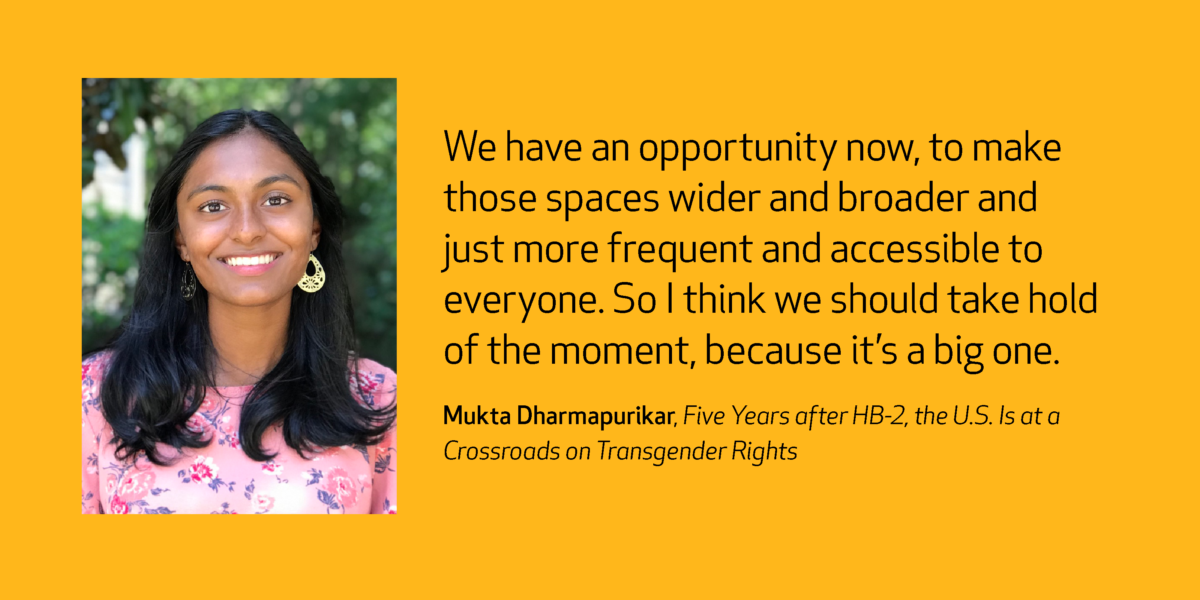A Gold Medal Portfolio Award is the highest honor students can receive in the Scholastic Art & Writing Awards. Jurors choose portfolios by high school seniors whose works best represent the Scholastic Awards’ judging criteria: originality, technical skill, and the emergence of a personal vision or voice. These remarkable artists and writers will each receive a $10,000 scholarship.
For the next few weeks, we’ll be profiling the 2022 Gold Medal Portfolio recipients. Next up are Mukta Dharmapurikar and Dessa Ely.
Mukta Dharmapurikar

Each unique voice and writing style showcases a different way to look beneath the surface, and I hope that my portfolio inspires the reader to take a second look at their own lives and understand the true impacts of the laws, stories, and even names we interact with every day.
Five Years after HB-2, the US Is at a Crossroads on Transgender Rights
JOURNALISM
Mukta Dharmapurikar, Grade 12, Durham Academy Upper School, Durham, NC. Gold Medal Portfolio, The New York Times Writing Portfolio Award
In 2016, Cameron had just come out as transgender, feeling simultaneously excited and scared about the future ahead. But when he heard about the controversial HB-2, which became North Carolina law that year and required transgender individuals to use restrooms based on the gender specified on their birth certificates, worry began to set in. Ordinary bathroom breaks began to seem like potentially life-altering decisions.
“It’s like okay, do I use a facility that’s aligned with my identity . . . and risk someone questioning why I’m there and potentially getting hostile or bringing up legal documents . . . or [go] to a women’s facility and [feel] very, very uncomfortable and equally as anxious?”
Now a rising junior at Duke University, Cameron has a better grasp on the impact that HB-2 had on his life growing up. He noted that even more than its legal implications, HB-2 had wide-ranging social impacts for transgender young adults like him, impacts that are still being felt around the state and country.
When it passed in 2016, HB-2 attracted national attention and outrage for being one of the first state laws to explicitly restrict the rights of transgender individuals. Thousands of trans youth like Cameron were put in an uncomfortable position every day at school. However, many don’t realize that HB-2 went far deeper than that. It also prevented local ordinances from passing laws to protect transgender rights, a statute that was even carried through HB-142, the 2017 bill to repeal HB-2. Cameron described HB-142 as “a small victory but a lot of confusion.” He notes that even though HB-2 was repealed, “the very fact that it was introduced is a signal that [transgender individuals] are not welcome here and that we are not safe.”
HB-2’s introduction brought transgender individuals to the forefront of national politics. It changed the way we see the government’s role in dictating the lives of individuals, setting a precedent for other states to follow. In 2017 alone, 16 states considered similar bathroom bills and six considered bills to limit transgender protections at the local level, according to the National Conference of State Legislatures.
Not only did HB-2 target an already stigmatized group, but it put clear legal implications behind that stigma. Something that may have resulted in strange looks before, such as visiting the bathroom matching one’s gender identity, now could result in a confrontation or even a lawsuit. It made an everyday action – using the restroom – into a crime. As conservative lawyer Ted Olson put it, “This law directly challenges the legitimacy of the identity of transgender persons and then compels them to deny it every time they use a public restroom.”
And this new fear still haunts transgender individuals, especially youth, today. For Cameron, it permanently changed his mindset. “Since HB-2, I’m a lot more hyper-aware of how others perceive me. I was already aware of that, but I think having a specific identity, that’s under such scrutiny . . . in parts of the national government . . . it puts you on your guard a lot more and it’s like, am I safe in this space?”
North Carolina’s moratorium on state and local action to protect transgender individuals expired this past December, after which city and local governments began to take rapid action. Cities like Asheville, Durham, and Greensboro have passed ordinances protecting transgender individuals, many of which took effect just this summer.
For Cameron, these laws are a huge step for transgender youth to feel more accepted. “If I were 14 or 15, just realizing I was trans now, growing up in those communities and seeing that my legislators were thinking about me and were looking out for me and setting up protections for me in my future, I think I would feel a lot safer and a lot more comfortable.”
However, while city governments pass protections, state governments are pushing for restrictions. North Carolina’s recently proposed “Save Women’s Sports Act” would prevent individuals from participating in sports divisions that don’t match their biological sex, blocking transgender youth from competing on a team that fits with their gender identity. Similarly, the “Youth Health Protection Act” and “Health Care Heroes Conscience Protection Act” could be used to deny transgender youth gender-affirming care. In total, 33 states have considered similar bills according to CNN using Human Rights Campaign data, setting a new record for anti-trans legislation. While some of these bills have been shot down, they’re likely to come up again as soon as this year, with states like Mississippi, Arkansas, and Tennessee already signing these measures into law.
Our country is once again at a crossroads on transgender rights. HB-2 continues to cast a shadow over state governments, but many city governments are moving in the opposite direction. Five years after one of the most infamous state laws in history – a law that cost North Carolina an estimated 3 billion dollars, cost a governor his reelection, and cost thousands of transgender individuals access to legal protections – the next chapter is still being written. Despite being repealed, HB-2 left a permanent impact. While it may have slowly trickled out of conversation topics, newspapers, and bathrooms, for transgender individuals like Cameron, its legacy remains ever-present. Every act of violence, lawsuit, or day-to-day awkward interaction transgender individuals face serves as a reminder of its grip on the state and country. But even in the face of that legacy, Cameron has thoughts about where we go from here:
“We have an opportunity now, to make those spaces wider and broader and just more frequent and accessible to everyone. So I think we should take hold of the moment, because it’s a big one.”
Dessa Ely

My work functions to help me reconnect with fundamental pieces of my identity. I examine the impermanence of innocence and childhood in a world that forces girls to grow up too fast. My art navigates the fragility of growing up mixed Asian in a world forged on Western ideals of separation.
Witnessing pieces of myself being created outside of myself allows me to process how these pieces fit into my own identity, and how I fit into the world.
Featured images: Dessa Ely, Beginning and End (Mixed Media) and Anthony (Mixed Media). Grade 12, Etobicoke School of the Arts, Toronto, ON. Gold Medal Portfolio, Scholastic Inc. Art Portfolio Award
To see more Gold Medal Portfolio recipients, past and present, visit our Eyes on the Prize series.

